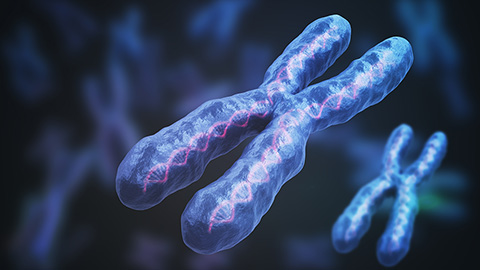Cholesterol as a novel biomarker for Fragile X syndrome
Fragile X syndrome, or FXS, is the most common inherited cause of intellectual disability in the U.S. Each year, thousands of people are diagnosed with the condition. Many patients’ families may be told their child will have the condition, with no real knowledge of what life will look like for their child.

While the cause of the disease is known — a mutation in the FMR1 gene — there is a wide range of symptoms among those with the trinucleotide repeat. Tests may catch the disease, but they do not give parents much guidance about what degree of learning disability to expect when raising their kids.
At the University of Sherbrooke in Quebec, Asma Laroui Artuela Çaku and Jean–Francois Lepage sought to identify better biomarkers of FXS function. Their work was published in the Journal of Lipid Research.
“We have access to the FXS clinic, which regroups patients from all around the province, so we can do a lot of associations between the lipid profile and the clinical phenotype,” Çaku said.
The team discovered that levels of 24S-hydroxycholesterol, or 24-OHC — a downstream metabolite of brain cholesterol — decreased in patients with FXS compared with controls. Cholesterol is synthesized in the brain by astrocytes, and excess amounts are converted to 24-OHC before being transported into peripheral circulation. Thus, a drop in 24-OHC in the blood offers a practical way to measure brain cholesterol metabolism in patients with FXS.
The researchers also found that 24-OHC levels were inversely correlated with several neurologic measures. Patients with lower 24-OHC showed slower motor evoked potentials, meaning their motor neurons fired less efficiently when stimulated by transcranial magnetic stimulation. On behavioral and cognitive questionnaires, patients with lower levels of 24-OHC reported greater difficulties with social communication as well as more symptoms of anxiety and depression.
Taken together, these results suggest that 24-OHC could serve as a useful biomarker to help clinicians give families a clearer picture of what to expect after an FXS diagnosis.
“We try to develop techniques that are not invasive,” Çaku said. “In a simple blood collection, you can have information about the brain.” These lipid profiles may help patients and their families better understand their neurologic development.
Laroui added that the findings also shed light on brain cholesterol biology more broadly.
“There is a lot of research from the peripheral, but comparatively fewer studies on brain cholesterol,” she said. “However, we found that in diseases where brain cholesterol is dysregulated, this imbalance can affect the phenotype. We are giving importance to research on brain cholesterol.”
The team now hopes to uncover the source of the abnormal cholesterol metabolism in FXS.
“Maybe it’s the enzyme that’s dysregulated, or maybe the astrocytes cannot produce enough cholesterol,” Laroui said.
Despite these unknowns, the researchers are optimistic that their work will deepen understanding of brain lipid metabolism and open the door to new tools for patient care.
Enjoy reading ASBMB Today?
Become a member to receive the print edition four times a year and the digital edition monthly.
Learn moreGet the latest from ASBMB Today
Enter your email address, and we’ll send you a weekly email with recent articles, interviews and more.
Latest in Science
Science highlights or most popular articles

Bacteriophage protein could make queso fresco safer
Researchers characterized the structure and function of PlyP100, a bacteriophage protein that shows promise as a food-safe antimicrobial for preventing Listeria monocytogenes growth in fresh cheeses.

Building the blueprint to block HIV
Wesley Sundquist will present his work on the HIV capsid and revolutionary drug, Lenacapavir, at the ASBMB Annual Meeting, March 7–10, in Maryland.

Gut microbes hijack cancer pathway in high-fat diets
Researchers at the Feinstein Institutes for Medical Research found that a high-fat diet increases ammonia-producing bacteria in the gut microbiome of mice, which in turn disrupts TGF-β signaling and promotes colorectal cancer.

Mapping fentanyl’s cellular footprint
Using a new imaging method, researchers at State University of New York at Buffalo traced fentanyl’s effects inside brain immune cells, revealing how the drug alters lipid droplets, pointing to new paths for addiction diagnostics.

Designing life’s building blocks with AI
Tanja Kortemme, a professor at the University of California, San Francisco, will discuss her research using computational biology to engineer proteins at the 2026 ASBMB Annual Meeting.

How lipid metabolism shapes sperm development
Researchers at Hokkaido University identify the enzyme behind a key lipid in sperm development. The findings reveal how seminolipids shape sperm formation and may inform future diagnostics and treatments for male infertility.

